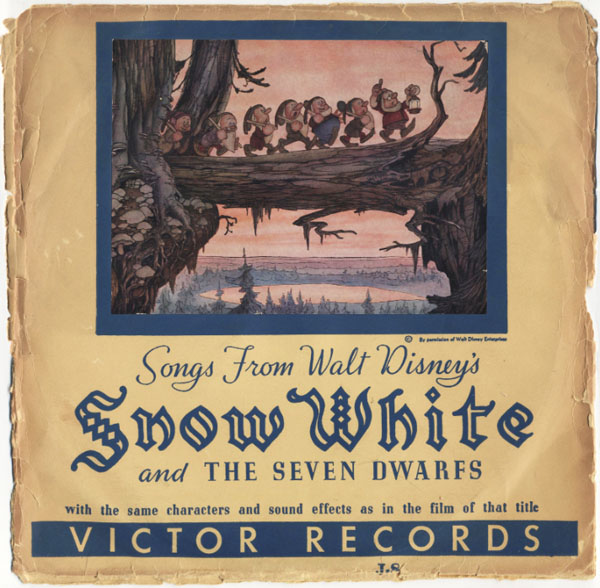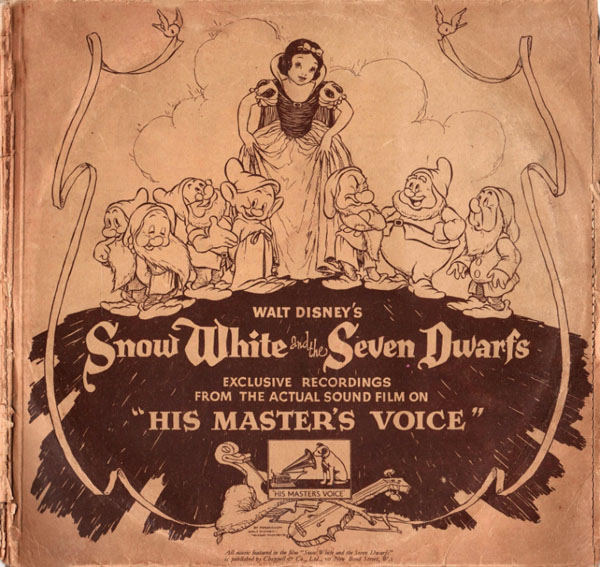
By now, everybody who is a cartoon fan knows the story. How people thought that Walter Elias Disney was off his rocker when he wanted to produce a feature-length animated cartoon.
And we all know how it turned out. Disney was crazy all right–crazy like a fox!
So, when it came time to promote the songs from what was, in essence, an animated operetta, why should Disney do the usual thing?
Instead, Disney did the unusual . . . the unexpected . . . the unimaginable. And it worked!
Between 1928 and 1935, Victor (later RCA Victor) had been recording film-to-disc transfers, and pressing them onto sixteen-inch discs for use by theaters that had invested heavily in the “Vitaphone” sound-on-disc process, and did not want to–or could not afford to–invest in the equipment required to play films with the new optical soundtracks. Occasionally, these discs will emerge from concealed hidey-holes, and command modestly impressive sums when these ponderous platters show up on Ebay.
For the “take home” trade, Victor had released a couple of discs dubbed from film soundtracks. In late 1931, they had put out a disc with a clip from the Universal film “Spirit of Notre Dame”, issued as “Knute Rockne Talks To His Team”, and coupled with a six-year-old recording of the “Notre Dame Victory March” by the Notre Dame Band. This was issued as a tribute to the first real celebrity football-coach, who had just died young.
In early 1934, Victor issued the song “Carioca”, from the sound track of “Flying Down To Rio”, played by the RKO Studio Orchestra under Max Steiner.

In England, Electrical and Musical Industries had not only produced the Disney sound track discs I spoke of earlier, but had a series of five discs produced for the Cinematograph Trade Benevolent Fund, These discs–called “Voices of the Stars”–featured snippets of dialogue and/or singing from various Britsh and American pictures, featuring various stars of the silver screen. These even included a clip of a speech from the unfinished 1937 version of “I, Claudius’.
But the idea of the “original soundtrack album” had not occurred to anybody–not yet,anyway!
We may never know who came up with the idea of doing an album of three records–six sides–featuring the popular airs from “Snow White”. But, somebody did–and it proved to be a hit all over the world!
There seems to have been two sessions held in late November and early December of 1937, at Victor’s studio in Hollywood. The six sides recorded at these sessions were issued as three consecutively-numbered 78 rpm discs. They may have come in a kind of paper, gate-fold “album”, well and profusely illustrated with line-drawings telling the story of “Snow Whte’ a la Disney.
One of the most interesting notes on these discs is that, in “Dwarfs’ Yodel Song” (nowadays often called “The Silly Song’), thee is a verse that does not appear in the movie. Lore had it that somebody at the Breen Office–Hollywood’s”Guardian of the Public Morals”–took exception to that particular verse.
Next: The Big Bands take on “Snow White”


 James Parten has overcome a congenital visual disability to be acknowledged as an expert on the early history of recorded sound. He has a Broadcasting Certificate (Radio Option) from Los Angeles Valley College, class of 1999. He has also been a fan of animated cartoons since childhood.
James Parten has overcome a congenital visual disability to be acknowledged as an expert on the early history of recorded sound. He has a Broadcasting Certificate (Radio Option) from Los Angeles Valley College, class of 1999. He has also been a fan of animated cartoons since childhood.












































In the recently released Pinto Colvig memoir (though written around 1940), Pinto writes that Snow White lyricist Larry Morey was “a young chap just out of university” and that “Walt tucked Larry under my wing to help him ‘find’ himself,” presumably to understand the Disney method and to loosen up to the studio’s gag style, including having Pinto as a performer of both song and also all manner of noise/sound fx. Morey ended up having a good range with lyrics, from the sentimental (“Someday My Prince Will Come”) to the silly. In fact, in one off-hand mention in the book, Colvig appears to cast himself as someone who collaborated on the Silly Song lyrics. If true, that is uncredited I believe, though certainly in the realm of likelihood. Is there much known about Morey being brought along into the studio’s musical comedy tradition by Colvig?
Colvig’s interaction with Morey may not have happened *exactly* the way he described it, but it’s true that he was heavily involved in development of the Entertainment Sequence in the story department, and his involvement extended to suggesting song lyrics. (And this wasn’t the first time; he had previously suggested lyrics for himself as the Grasshopper in “The Grasshopper and the Ants.”) Five different songs were written for the dwarfs to sing before Walt and the writers settled on the final one, and Colvig wrote lyrics for some of them. The fifth and final choice, “The Silly Song,” apparently started as a Colvig opus titled “Gee, Ain’t This a Silly Song?” He wrote several couplets for it as it evolved, but his position at the studio was getting tenuous by that time, and it’s not clear whether any of his lyrics ended up in the final version.
Has anyone ever recorded the male version of Prince. It is an entirety different lyric. I believe the title is Someday I’ll Find My Love. Was it ever meant for use in the film. There is also a full title song.
Hi James. Very interesting about the earlier film soundtrack single releases. I wasn’t aware of those.
The original Victor issue wasn’t in an album – it was just the thick yellow paper envelope with the three records in generic Victor sleeves, as pictured at the top of this article. I managed to score a very nice complete set on Ebay at a very fortuitous price a few years ago. The color Gustav Tenggren illustration is printed on a separate glossy sheet glued to the front. The back is blank, and had a flap.
There never was a nicely illustrated gatefold issue of the Victor soundtrack set. In fact, some later copies just had generic artwork with no Disney characters at all! Now the British HMV issue – it was spiffy.
A dub of the Yodel Song I sent to Jerry in 2011 resulted in this article: http://www.cartoonbrew.com/disney/a-lost-snow-white-lyric-found-52066.html . Please read the comments, as there are some corrections by people who would know much better than I do (and I was zonked on cold medication at the time, which didn’t help a bit).
And then check out the series of posts on the Filmic Light blog, starting with this one: http://filmic-light.blogspot.com/2013/01/1938-snow-white-soundtrack-78-rpm.html
He discusses some soundtrack discrepancies on other records in the set here: http://filmic-light.blogspot.com/2013/01/heigh-ho-deleted-segment-from-original.html
Here’s what Sneezy sang in that missing 2nd verse …
A minute after I was born
I didn’t have a nightie.
So I tied my whiskers round my legs
And I used them for a dy-a-dee. (AAAAA-CHOOO!!)
Rather odd the recording starts right after “The Dwarves’ Yodeling Song” ends.
Always wondered about HMV’s relationship to Victor, since both used the same trademark. Did HMV begin as a British subsidiary of Victor, and Gramophone Co./EMI took over after RCA bought Victor?